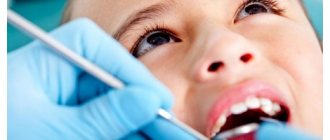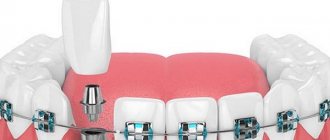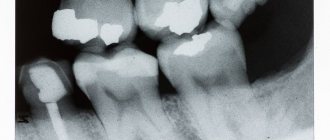The replacement of baby teeth with permanent ones is a natural physiological process that every child experiences. It usually begins in preschool age and proceeds without difficulty. But parents need to approach it responsibly, since any violations when changing teeth are fraught with unpleasant consequences. This may be the formation of a malocclusion, uneven teeth, or the occurrence of a diastema (interdental gap).
In this article we will consider the correct sequence of tooth replacement, possible violations, and situations when consultation with a pediatric dentist is necessary.
Why and when do baby teeth change?
As the child grows, the dentofacial apparatus also develops. At approximately 4–6 years of age, the preparatory stage begins, during which interdental spaces appear. This prepares the place for permanent teeth in the primary dentition.
The process of replacing baby teeth with permanent teeth is a slow process, taking approximately 6 or 7 years (until adolescence). Active growth of the roots of permanent teeth activates the process of bone resorption - this is the destruction (dissolution) of milk roots, which leads to loosening and tooth loss. Standard diagram of the sequence of changing baby teeth in a child.
- Central lower incisors (5–7 years). They fall out one by one with a short time interval.
- Lateral incisors (7–8 years).
- First molars on the upper jaw, second molars on the lower jaw (9–11 years)
- Cone-shaped teeth (canines) at the age of 9–12 years.
- Second molars on the upper jaw and first molars on the lower jaw (10–13 years)
Not everyone's third molars (wisdom teeth) erupt. This is considered the norm. Most often, the optimal age for them is considered to be from 17 to 25 years.
Reference!
The later the first teeth erupted in infancy, the later they will be replaced in preschool age.
By the age of 15–16, a teenager’s permanent bite should number 28 units.
How many baby teeth do children have?
So how many baby teeth do children lose? In a newborn, in the depths of the upper and lower jaws there are only 20 rudiments of temporary teeth - 10 follicles for each jaw. It should be noted that the formation of follicles begins already at 6-7 weeks of embryonic development, and when a child is born, the crowns of his baby teeth are already fully formed (although they have not yet erupted). But the formation of the roots of baby teeth continues to occur after the birth of the child.
Studies have shown that a baby tooth begins to erupt when its root is 25-50% formed. One of the theories of eruption says that the developing root, as it were, pushes the baby tooth out of the jaw. Normally, the process of teething in the primary occlusion begins at 5-6 months, and in completely healthy children it ends by 24 months (the last to erupt are the temporary fifth molars). In diagram No. 1 you can see how many baby teeth children should have depending on their age.
Scheme of teething in children without pathology (scheme No. 1) –
→ Eruption of baby and permanent teeth
In diagram No. 1 you can see the timing of the eruption of baby teeth - in completely healthy children who do not have any pathology. These data are taken from the National Guide to Pediatric Dentistry. But if there is (for example, any somatic pathology), the timing of the eruption and loss of baby teeth can shift by 3-5 months. Below in the article we will tell you at what time children’s baby teeth fall out and what leads to this.
What deviations from the norm may there be?
Each child develops individually. Sometimes the timing of the replacement of certain teeth may differ from the generally accepted norm. Minor deviations are allowed up to 12 months. But sometimes the change in the primary bite begins too early or, on the contrary, the temporary teeth do not want to fall out.
Causes:
- long-term breastfeeding;
- severe infectious diseases in infancy;
- pathologies of intrauterine development.
Reference!
Dentists believe that a safer deviation is a late change in the primary occlusion than vice versa.
Let us consider in detail the common violations and their causes.
Early tooth loss
We can talk about such a pathology if a child’s baby teeth begin to fall out before the age of 5. Possible reasons:
- advanced multiple caries;
- injury;
- gum disease;
- manual loosening of the tooth.
In all these cases, consultation with a pediatric dentist is required.
Important!
Parents should record the time of tooth loss. If after 4 months the permanent tooth does not begin to emerge, then the help of a doctor is required.
In case of early unnatural tooth loss, it is advisable to conduct an X-ray diagnosis. This will help to identify possible damage to the permanent root rudiment in time and begin treatment. Otherwise, the child will need prosthetics in the future.
Late change from primary to permanent occlusion
The deadline for starting the process of changing baby teeth is 8 years. But this is considered a late shift. The disorder may be caused by:
- heredity;
- metabolic disorders;
- infectious diseases suffered in early childhood;
- mental disorders.
If after 8 years a child has not lost a single baby tooth, this is a reason to consult a doctor.
Possible abnormalities in the child
Parents should know when to expect changes in their child's bite . Late change of baby teeth, like premature change, is undesirable. They speak of lateness when an eight-year-old child has not yet lost any of his incisors; they speak of early eruption if a five-year-old child has already lost many of his incisors and fallen out. It is important to find out the cause of the changes occurring and, if possible, eliminate it.
Factors due to which the bite changes earlier than standard periods:
- severe jaw injuries;
- congenital diseases leading to anomalies in the eruption of temporary and permanent units;
- advanced caries, due to which crowns and roots are destroyed faster than necessary.
As for a late shift, it is possible due to:
- rickets, calcium and vitamin D deficiency in the child’s body;
- hereditary characteristics of the dentofacial apparatus;
- some infectious pathologies.
Reasons for late eruption
Normally, after a baby tooth falls out, it takes 1-2 months for the permanent tooth to erupt. This is the longest period. In most cases, the rudiments of a permanent tooth can already be seen at the site of the lost tooth.
But, if a child’s toothless smile persists for 3 months or more, then this is a cause for concern for parents.
Let's consider why such dental pathology occurs:
- Retention
– a common condition that mainly affects the incisors and canines. They cannot erupt due to dense gums or because they rest against neighboring teeth. There are complete and partial retention. With the full form, a healthy root is visible in the picture, but it is completely under the gum. With partial retention, only part of the crown is visible. In this case, surgical assistance is required.
- Edentia
– a congenital pathology in which there is a lack of rudiments of permanent dental units. Can be complete or partial (sparse teeth). A rare disease. Orthopedic treatment is required as early as possible.
- Impact
– delayed eruption in this pathology is associated with a mechanical obstacle, that is, the child has a supernumerary of dental units. In this case, the permanent root simply does not have room to erupt. Impaction can only be detected using a panoramic x-ray of the jaw.
The sooner the child is examined by a doctor, the higher the chance of having an even and complete dentition.
What problems do children and their parents face when replacing baby teeth with molars?
As mentioned above, first the root of the baby tooth is absorbed. In this case, the loss occurs painlessly on its own or under the influence of external signs (constant loosening by the child or eating fairly solid food). But it may also happen that the root of the tooth has not yet been sufficiently absorbed, the baby tooth has not yet fallen out, but the molar has already begun to grow. If you do not consult a dentist in time to remove a tooth that is interfering with natural growth, a significant malocclusion may occur: a molar may simply grow next to the baby tooth. Such changes in the oral cavity may be accompanied by an increase in body temperature and significant pain.
Another significant problem is teeth falling out too early. It can be caused by various gum diseases or physical trauma. If you do not seek advice from a specialist in time, the gums may become overgrown at the site of tooth loss, which will subsequently prevent the eruption of a molar at this site and the curvature of the dentition. In this case, they usually resort to prosthetics. A structure made of hypoallergenic materials is installed on the damaged area, completely identical in appearance to a natural tooth. It maintains the child’s neighboring teeth in an even state, preventing the formation of an incorrect bite.
Another significant problem is the delay in tooth loss, when the molar is already beginning to erupt, but the milk tooth is still quite firmly “sitting” in its place. This may be due to a lack of nutrients, delays in the development of the body in general and the oral cavity in particular. In this case, you should contact a dentist, who will examine the little patient in detail and prescribe the necessary measures. In most cases, the tooth that is preventing growth is simply removed. In this case, local anesthesia is used, which will make the process of tooth extraction almost painless.
Newly erupted molars are not yet strong enough; their tooth enamel is thinned. Therefore, during the period when baby teeth are replaced by molars, there is an increased risk of acquiring dental diseases. The most significant of them is caries. It can occur due to poor oral hygiene and consumption of large amounts of sweet foods. If caries is not treated in time, complications in the form of pulpitis and other dangerous dental diseases are possible. There is also a possible risk of damage to the oral cavity during this period by various types of infections, which often lead to inflammation of the gums and loss of newly grown teeth.
Replacing baby teeth with molars is a very important process for a child. Parents should do everything possible to make it enjoyable and painless. Therefore, it is very important to visit the pediatric dentist on time.
Possible problems when changing baby teeth
Common dental pathologies when changing a primary dentition to a permanent one include:
- Shark teeth. A phenomenon in which baby and permanent teeth are located parallel to each other, in 2 rows. This arrangement can interfere with the normal development of the dental system. But in most cases, the temporary root becomes loose, and the “extra” tooth falls out on its own. If this does not happen, removal at the doctor's office is recommended.
- Increased pain. Sometimes a change in the milk bite is accompanied by increased body temperature, redness of the gums and severe pain. These symptoms usually accompany early or late change of teeth. Inflammatory diseases of the oral cavity may also be the cause.
- The appearance of a hematoma.
In rare cases, when molars erupt, a hematoma occurs on the gum in the form of a small bubble with an accumulation of blood. This occurs due to severe eruption, which leads to rupture of blood vessels. The gums may be pale in color. Pain and discomfort occurs. If suppuration occurs, medical attention is required.
If pathological phenomena do not go away for a long time, and the child is irritable and complains of pain, be sure to visit the dentist.
Tips for tracking the eruption of permanent teeth
The condition of a child's primary teeth can have a significant impact on the sequence of eruption of molars. Research has revealed a relationship between the consequences of complicated caries of primary teeth and a violation of the location of permanent teeth and deformation of the dental arch [7].
By carefully monitoring the health of baby teeth and the process of eruption of molars, and turning to specialists in a timely manner, parents will help their children acquire and maintain orthodontically correct dentition - the key to a beautiful smile.
What not to do when baby teeth fall out
Incorrect actions of children and parents can lead to the formation of malocclusion, increased pain, or the formation of crooked teeth. To avoid this, it is recommended to adhere to the following rules:
- Don't help baby teeth fall out if they are straight and not loose. Even if, according to the child’s age, it is high time for him to have a toothless smile.
- Don't loosen your teeth with your hands. And do not pull them at home, for example, with a thread.
- Baby teeth are quite fragile in preschool age. Therefore, your child should not indulge in solid foods. The crown may break, but the root will remain in the gum.
- If a tooth falls out, do not allow your child to touch the socket with his tongue or hands. Gentle rinsing with antiseptic solutions or herbal decoctions is recommended.
If you have a fever, cough or lethargy, do not rush to resort to antiviral drugs. Poor health can be a harbinger of the imminent change of baby teeth.
Symptoms of eruption of permanent teeth
The process of such serious internal changes is accompanied by external manifestations:
- irritability;
- change of mood;
- increased salivation;
- swelling of the gums;
- Looseness of a baby tooth.
If pain from a teething tooth causes serious discomfort, your doctor may recommend taking painkillers approved for children to alleviate the condition.
Tips for parents
During the period of teeth change, you should enrich your baby’s food with foods that are rich in calcium. To prevent inflammation in your mouth, make it a habit to rinse your mouth every time you eat or have a snack. As permanent teeth erupt, offer your baby soft or liquid foods. Avoid hot drinks.
If slight bleeding occurs when a baby tooth falls out, do not use alcohol tinctures. Apply a cotton ball to the wound and do not allow food for 2 hours. In order to promptly identify possible irregularities in the eruption of the permanent dentition, it is recommended to record the date of baby tooth loss.
Beautiful, straight and healthy teeth in adults are the result of proper care in childhood. Therefore, parents should teach their child proper oral hygiene from the first tooth.
Delay in loss of primary teeth
Your child is finishing school, but some of his baby teeth have not yet been replaced by permanent ones? It is worth making an appointment at a dental clinic. Temporary teeth that remain in their places for too long are a sign that there are disturbances in the functioning of the child’s body.
Late tooth loss can be caused by:
- abnormal location of the permanent tooth germ;
- regular stress;
- malnutrition and lack of vitamins and microelements;
- chronic diseases.
Do you want your child to have straight and healthy permanent teeth? Do not neglect preventive examinations at the dentist twice a year.
What to do if the tooth, on the contrary, does not loosen
If a molar is already visible above the baby tooth, which is about to erupt, then this is a reason to visit an orthodontist. If such a baby tooth is not removed in a timely manner, then an expensive bite correction will be required to force the permanent tooth to fall into its proper place.
In this case, an orthopantomogram will also help, which will allow you to see where the molars are located.










